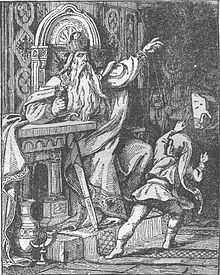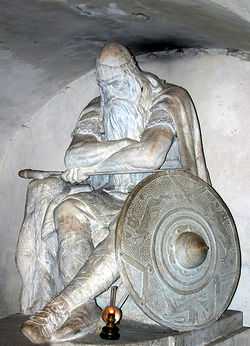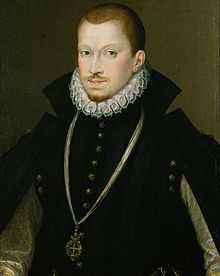King in the mountain
A king in the mountain, king under the mountain or sleeping hero is a prominent motif in folklore and mythology that is found in many folktales and legends. The Aarne-Thompson classification system for folktale motifs classifies these stories as number 766, relating them to the tale of the Seven Sleepers of Ephesus.
General features

King in the mountain stories involve legendary heroes, often accompanied by armed retainers, sleeping in remote dwellings, including caves on high mountaintops, remote islands, or supernatural worlds. The hero is frequently a historical figure of some military consequence in the history of the nation where the mountain is located.
The stories gathered by the Brothers Grimm concerning Frederick Barbarossa and Charlemagne are typical of the stories told, and have been influential on many told variants and subsequent adaptations. The presence of the hero is unsuspected, until some herdsman wanders into the cave, typically looking for a lost animal, and sees the hero. The stories almost always mention the detail that the hero has grown a long beard, indicative of the long time he has slept beneath the mountain.
In the Brothers Grimm version, the hero speaks with the herdsman. Their conversation typically involves the hero asking, "Do the eagles (or ravens) still circle the mountaintop?" The herdsman, or a mysterious voice, replies, "Yes, they still circle the mountaintop." "Then begone! My time has not yet come."
The herdsman is usually supernaturally harmed by the experience: he ages rapidly, he emerges with his hair turned white, and often he dies after repeating the tale. The story goes on to say that the king sleeps in the mountain, awaiting a summons to arise with his knights and defend the nation in a time of deadly peril. The omen that presages his rising will be the extinction of the birds that trigger his awakening.[1][2]
Examples
A number of kings, rulers, fictional characters and religious figures have become attached to this story. They include the following:
- Emperor Frederick II, Holy Roman Emperor.
- Emperor Constantine I, said to have been turned into a stone statue, although not resting within a mountain.
- Constantine XI Palaiologos, the last emperor of the Eastern Roman Empire, said to have been turned into marble and thus was known as "Marmaromenos", "the Marble King". He was said to be hidden somewhere underground until his glorious return as the Immortal Emperor.
- Emperor John III Doukas Vatatzes (also known as "Kaloyannis III'") of the Eastern Roman Empire, due to his kindness and ability, also known as "Marmaromenos" -- although this title might also be due to the post-mortem discovery of the his intact body, the peculiar appearance of which was caused by a lifetime of medical treatment for epilepsy. (Greece, Cyprus)
- Merlin of the Arthurian legend, who is imprisoned in an oak tree by Nimue.
- Bran the Blessed (Wales)
- St. John the Evangelist (Ephesus, Turkey) who some said was only sleeping in his grave until the coming of Antichrist, when he would be needed as a witness.[3][4]
- Csaba, the son of Attila the Hun (Hungary) who is supposed to ride down the Milky Way when the Székelys are threatened.
- King St. Stephen, King St. Ladislaus, King Matthias Corvinus (Hungary)
- Kralj Matjaž (Slovenia)
- Emperor Charlemagne (Germany, France) rests in the Untersberg near Salzburg.
- Fionn mac Cumhaill (Ireland), is said to sleep in a cave/mountain surrounded by the Fianna (he is differentiated from them because of his large stature). It is told that the day will come when the Dord Fiann is sounded three times and Fionn and the Fianna will rise up again, as strong and well as they ever were. In other accounts he will return to glory as a great hero of Ireland.[5]

- Ogier the Dane (Danish: Holger Danske, Denmark)
- King Harold (England). Said to have not been slain at Senlac by Anglo-Saxon legends, to come one day to liberate the English from the Norman yoke[6]
- King Rodrigo (Spain). Said to escape from the Moorish invasion and await for "the time of maximum need" to save his people.
- Vytautas the Great (Lithuania) He is believed to rise from its grave when the worst danger will threaten Lithuania to defend the motherland at the last battle.
- Owain Lawgoch
- Owain Glyndŵr (Wales) The Last native born Welshman to hold the title "Prince of Wales"; he disappeared after a long but ultimately unsuccessful rebellion against the English. He was never captured or betrayed and refused all Royal pardons.
- Emperor Frederick Barbarossa (Germany) sleeps in the Kyffhäuser mountain and will rise to save the Empire
- King Henry the Fowler (Germany)
- King Pelayo (Spain)
- Key-Khosrow legendary shah of Persia
- The legendary Moravian king Ječmínek will, according to a prophecy, return to save his country from enemies.[7]
- An unnamed giant is supposed to sleep in Plynlimon in Wales.
- Giewont massif which is said to be a sleeping knight (Poland)
- The remains of the Golem of Prague are said to be in the attic of the Old New Synagogue in Prague, and that it can be brought back to defend the Jewish people. (Jewish mysticism)
- Gerald FitzGerald, 8th Earl of Kildare (Ireland)
- The Pueblo hero-god Montezuma — believed to have been a divine king in prehistoric times, and suspended in an Arizona mountain that bears his image.
- Bernardo Carpio the "King of the Tagalogs" said to reside in the mountains of Montalban, Philippines.
- Muhammad al-Mahdi (Islamic mysticism, especially Shi'a)
- Marko Kraljević (Serbia)
- King Olaf I (Norway)
- Väinämöinen, the protagonist of the Finnish national epic Kalevala. At the end of Kalevala, he leaves on a boat, promising to return when he is most needed.
 Sebastian I, with whose death the house of Aviz lost its throne. Sebastianists hold that he will return to rule Portugal's Fifth Empire.
Sebastian I, with whose death the house of Aviz lost its throne. Sebastianists hold that he will return to rule Portugal's Fifth Empire. - Sebastian I, (Portugal) (it is said by Sebastianists that the king will return in a hazy morning in time of need)
- The Sleeping Ute mountain in Colorado is said to have been a “Great Warrior God” who fell asleep while recovering from wounds received in a great battle with “the Evil Ones” (there are many other variants of this legend)
- Vlad III the Impaler (Romania)
- The poet and painter Taras Shevchenko (Ukraine), believed to be a supernatural hero (charakternik), is said to sleep under his grave mound in Kanev or even in the Kiev Pechersk Lavra.
- Tecumseh of the Shawnee
- William Tell (Switzerland, in some legends accompanied by two other Tells[8])
- Thomas the Rhymer is found under a hill with a retinue of knights in a tale from Anglo-Scottish border. Likewise, Harry Hotspur was said to have been hunting in the Cheviots when he and his hounds got holed-up in the Hen Hole (or "Hell-hole") awaiting the sound of a hunting horn to awaken them from their slumber. Another border variant concerns a party of huntsmen who chase a roebuck into the Cheviots when they heard the sweetest music playing from the Henhole, however when they entered they became lost and are trapped to this day.[9]
- St. Wenceslas (Václav) of Bohemia (Czech Republic). He sleeps in the Blaník mountain (with a huge army of Czech knights) and will emerge to protect his country at its worst time, riding on his white horse and wielding the legendary hero Bruncvík's sword.[7]
- Boabdil, last Islamic prince of Granada.
- Lāčplēsis, the eponymous hero of the Latvian epic poem. It is said that he will rise out of the Daugava River when his country needs him to again take on her attackers and invaders. Alternatively, he will rise out of the Daugava at the end of the world.
- Matija Gubec (Croatia)
- Napoleon Bonaparte was considered to be also not dead but in Irkutsk and to come back by a Slavonic sect[10]
- King David is depicted in Haim Nachman Bialik's tale "King David in the Cave" as sleeping along with his warriors deep inside a cave, waiting for the blast of the ram's horn that will awaken them from their millennia of slumber and arouse them to redeem Israel.[11][12] This role was not attributed to King David in earlier Jewish tradition.
- Theseus (Athens)
- King Arthur (Great Britain) perhaps most famous of the king under the mountain examples. Arthur according to legend was taken away to the Isle of Avalon to sleep until he was needed by the people of Britain, but several legends talk of a herdsman who stumbles across a cave on mainland Britain in which he finds Arthur sleeping, often with his knights and Excalibur by his side. In a variation on this, sometimes the exploring herdsman finds instead just Arthur's knights, or Sir Lancelot, Guinevere and the knights sleeping in wait on the return of the "Once and Future King".
- Sir Francis Drake (Great Britain) - In this legend, it is stated that when England is in deadly peril, if Drake's Drum is beaten, then Sir Francis Drake will arise to defend England from the sea. According to legend, it can be heard to beat at times when England is at war or significant national events take place.
- Knights of Sitno in Slovak mythology are a legion of knights supposedly sleeping inside the mountain Sitno in Central Slovakia, waiting to be called upon in times when the Slovaks are in danger. It is said that every seven years, the oldest of them climbs up the hill and shouts the question: "Is it time yet?" in every world direction. If nobody answers, he climbs back inside.[13]
Sleeping anti-hero and villain
Sometimes this type of story or archetype is also attached to not-so-heroic figures, who are either simple anti-heroes or fully villains, whose return would mean the end of the world, or whose sleep represents something positive. This kind of archetype is known as the "Chained Satan" archetype.[14] Among examples of this are:
- The Sleeping Giant mountain in Connecticut, United States was said by the local Quinnipiac Indians to be the demon Hobbomock, sealed by the Great Spirit. One day he would supposedly awaken and destroy the world
- Mher (Armenia)[15]
- Artavasdes II of Armenia, who according to Moses of Chorene was chained and cursed to stay eternally chained by his father Artaxias II.[14]
- Loki in Norse mythology was bound by the gods after he engineered the death of Baldr. With the onset of Ragnarök, Loki is foretold to slip free and fight alongside the forces of the jötnar against the gods.
- Dukljan
The sleeping hero in popular culture
- A version of the sleeping hero legend is included in several entries in the Nintendo game franchise 'The Legend of Zelda', most explicitly in the Gamecube game The Legend of Zelda: The Wind Waker and the most iconic of the series The Legend of Zelda: The Ocarina of Time.
- American comic book icon Captain America fell into suspended animation at the end of World War II, only to be awakened later.
- American comic book super hero Captain Marvel from Fawcett Comics, after having been cancelled in 1953, was given a story where he (and most of his friends and his arch foes) was trapped in suspended animation for 20 years to explain his revival in 1973 by DC Comics.
- In the Final Crisis: Superman Beyond comic series, a mysterious statue, resembling Superman, is left behind by the original Monitor, to activate only when the DC Multiverse is endangered.
- British author Susan Cooper makes use of the return of King Arthur and the awakening of sleeping heroes as plot elements in The Dark Is Rising Sequence.
- At the end of the video game Halo 3 the protagonist, the Master Chief, is placed into suspended animation with the words "Wake me, when you need me".
- In music, a single by Kate Bush released on 24 October 2005 is named "King of the Mountain". This song connects popular beliefs about Elvis Presley's death, with references to Citizen Kane also, to the "King in the Mountain" motif.
- In The Books of Magic, Timothy Hunter sees the mystical King in the mountain and talks to a minstrel who is guarding his grave.
- In Robert Jordan's The Wheel of Time, heroes from ages past reside in the world of dreams until they are called forth to fight the Dark One.
- In the Transformers Marvel Comics series, the Last Autobot, a final repository of some of the power of the Transformers' god Primus, waits at the center of Cybertron.
- The plot of the book The Weirdstone of Brisingamen by Alan Garner revolves around a Cheshire variant of the legend.
- The main character in the 2006 science fiction series The Lost Fleet by John G. Hemry (writing as Jack Campbell) is a mythical hero to his people. He is rediscovered on the eve of a large calamity and must return the remnants of his nations military from being trapped deep behind enemy lines. The author was inspired by the King Arthur myth.
- In That Hideous Strength by C. S. Lewis, which was the third book in a trilogy preceded by Out of the Silent Planet and Perelandra, the main character in the series (a philologist named Elwin Ransom) summons Merlin.
- J. R. R. Tolkien uses the king in the mountain in various places in his legendarium: the form of the Dead Men of Dunharrow, the armies and king of Númenor who are trapped by the Valar when Númenor is destroyed, and in the Second Prophecy of Mandos which states that the dead heroes Túrin and Beren would return to help to defeat Morgoth at the end of times. The Dwarf-lords of Erebor are formally known as the Kings under the Mountain.
- In the table-top roleplaying game GURPS Technomancer, Joseph Stalin acted in similar role for the Soviet Union; in this alternative history setting, he didn't die in 1953, but rather was put in a magical sleep under the Moscow Kremlin. In 1996, after the fall of the USSR, he awoke and led a rebellion against the Russian Federation.
- Cthulhu is a famous literary example of the Sleeping Anti-Hero/Villain variant. In The Call of Cthulhu and several other Cthulhu Mythos stories he is said to "wait dreaming" in a sunken city until "the stars are right" when he will wake up and destroy human civilization.
- The video game Skyrim contains many antagonists, called Draugr, that follow the King in the Mountain motif, in that they wake up as the Dragonborn approaches.
See also
- Seven Sleepers
- Rip Van Winkle
- Honi HaM'agel
- Sidhe
- King Arthur's messianic return
References
- ↑ Jacob and Wilhelm Grimm, Deutsche Sagen (1816/1818), no. 23.
- ↑ Kaiser Karl im Untersberg (German)
- ↑ Isidore of Seville - De ortu et obitu patrum (5th century)
- ↑ Jacobus de Voragine - The Golden Legend
- ↑ Augusta, Lady Gregory - Gods and Fighting Men (1904)
- ↑ The Science of Fairy Tales: An Enquiry Into Fairy Mythology, Edwin Sidney Hartland, 1925 edition, p. 143
- ↑ 7.0 7.1 Alois Jirásek, Old Bohemian Legends (1894, Staré pověsti české)
- ↑ The Three Tells
- ↑ Henry Tegner; Ghosts of The North Country, 1991 Butler Publishing, ISBN 0-946928-40-1. p.13
- ↑ The Science of Fairy Tales: An Enquiry Into Fairy Mythology, Edwin Sidney Hartland, 1925 edition, p. 144
- ↑ "Canaanism:" Solutions and Problems, Boas Evron, Alabaster's Archive
- ↑ הַמֶּלֶךְ דָּוִד בַּמְּעָרָה ח"נ ביאליק
- ↑ http://sitnoholding.sitnobusiness.com/en/the-legend/
- ↑ 14.0 14.1 Mher in the Carved Rock, J. A. Boyle, p. 11, at the Library of the University of Canterbury, Christchurch, New Zealand
- ↑ Mher in the Carved Rock, J. A. Boyle, at the Library of the University of Canterbury, Christchurch, New Zealand